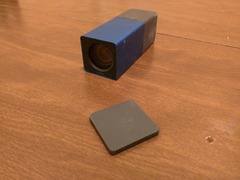 Sometimes you find parallels to the e-book business in the most interesting places.
Sometimes you find parallels to the e-book business in the most interesting places.
Tonight I ran across an essay by Jason Rosenthal, CEO of Lytro. Lytro came up with the groundbreaking light field camera technology that allows capture of an image in such a way it can be refocused after the fact. I have one of their cameras; I mentioned it in my article about my gadget bag.
In the essay, Rosenthal discusses his prior experiences working for Loudcloud and Ning, and how those experiences led him to realize Lytro needed to make a dramatic change in its business model. The fundamental problem was that light field cameras simply weren’t going to be “a winning product.”
While consumer Light Field cameras offered a number of true technological breakthroughs such as interactive 3D pictures, radical lens specs, and the ability to focus a picture after the fact we had a number of disadvantages as well including 4X larger file sizes and lower resolution in comparison to other similarly priced cameras. The cold hard fact was that we were competing in an established industry where the product requirements had been firmly cemented in the minds of consumers by much larger more established companies. This issue was compounded by the fact that the consumer camera market was declining by almost 35% per year driven by the surge in smartphone photography and changing consumer tastes.
Subsequently, Lytro decided to stop making those cameras for consumers and pivot to developing light field technology for virtual reality applications instead. It was a tough decision, but Rosenthal was confident it was the right one—and he writes that subsequent performance of Lytro Immerge seems to have borne that conclusion out.
 From my own experiences with the Lytro, I’d have to say he’s right. Overall, it just isn’t as useful as a regular camera for my own needs. It does have a great (huge) lens, and I’ve been able to capture some pictures at extreme zoom I couldn’t have gotten with my smartphone cameras. But overall, it takes lower-resolution pictures and I’ve almost never actually needed the ability to refocus a photo I took after I took it.
From my own experiences with the Lytro, I’d have to say he’s right. Overall, it just isn’t as useful as a regular camera for my own needs. It does have a great (huge) lens, and I’ve been able to capture some pictures at extreme zoom I couldn’t have gotten with my smartphone cameras. But overall, it takes lower-resolution pictures and I’ve almost never actually needed the ability to refocus a photo I took after I took it.
I just keep coming back to a line from that paragraph I quoted. “The cold hard fact was that we were competing in an established industry where the product requirements had been firmly cemented in the minds of consumers by much larger more established companies.” The thing this most strongly reminds me of is Barnes & Noble and its Nook.
The Nook has been hanging on by its fingernails for the last few years, with an e-reader that’s effectively an also-ran to the Kindle. It’s not inferior to the Kindle technologically, at least not in any way that matters, but for whatever reason B&N hasn’t been able (or willing?) to compete with Amazon. It can’t offer a compelling alternative to Amazon’s more-established Kindle. The brick and mortar stores are actually doing pretty well, but the Nook isn’t.
B&N has already stopped making its own branded Android tablet hardware—but perhaps it’s time to pivot away from making e-ink readers, too. Given how tablets are taking off, perhaps the e-ink Nook is no longer quite so necessary. The company that makes e-ink screens, E Ink Holdings, seems to see things that way, given that it is itself pivoting away from e-ink readers in favor of electronic labeling, wearable devices, signage, and other applications.
B&N could still sell e-books for its mobile apps, and not have to deal with the costs to manufacture, carry, and support the hardware inventory. It’s already gotten rid of its Nook-branded Android tablets in favor of a partnership with Samsung, and it’s gotten out of the e-reader trade altogether in the UK. Can leaving the business elsewhere be far behind?
It would be preferable if B&N were able to compete with Amazon better, because any company as powerful as Amazon needs all the competition it can get—but that ship seems to have sailed. B&N has had several years in which to make improvements, but instead it keeps finding ways to make the Nook platform less useful. Maybe it’s time to stop pouring money down the toilet.
Regardless, if there’s one thing Rosenthal’s essay demonstrates, it’s that if your current product or service offering simply isn’t cutting it, you need to pivot away from it to find a better alternative. Perhaps Barnes & Noble should take that advice.































